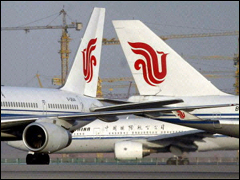Air China hopes to grow its market share in Beijing to 50 per cent from a current 44 per cent after it moves to Beijing Capital International Airport's new third terminal next March.
The flag carrier planned to boost its market share by increasing flights overseas as well as exploring untapped markets such as Pyongyang, the capital of North Korea, with the help of an expanded fleet of aircraft to be delivered in the next three to four years, said vice-president Zhang Lan.
Ms Zhang's comments came during a press briefing in Beijing on Friday.
The new runway and terminal at Beijing's main airport was built primarily for Air China and its code-share partners such as Lufthansa, Dragonair and Cathay Pacific Airways.
Planners expect the expansion to boost traffic capacity at the overloaded airport by one-third - a move designed to resolve the overwhelming growth in airline traffic driven by the Beijing Olympics and the buoyant economic growth in the mainland.
"We want to increase our service as much as possible, growing our market share to 50 per cent at least," said Ms Zhang.
The airline operates 160 to 180 domestic flights and 60 to 80 international flights from Beijing daily.
"Inter-line passenger traffic will grow substantially as we officially join the Star Alliance by the end of the year," added Ms Zhang.
Air China signed a memorandum of understanding with Star Alliance last May, but some in the market believe the agreement may not proceed, since Cathay, which holds a strategic stake in Air China, belongs to a different alliance.
But Ms Zhang insisted the proposed alliance would proceed. "We will definitely join Star Alliance by the end of the year. We want to connect international passengers to every city in China and deliver Chinese travellers to every destination in the world," she said.
So far, 40 of 57 Star Alliance entry requirements had been fulfilled by Air China, and all the requirements would be fulfilled by year-end, Ms Zhang said. In preparation for the alliance start-up, Air China had begun briefing sessions with 30 domestic airports on luggage check-through systems, she added.
Meanwhile, seven of the 20 Airbus 330s ordered by Air China have been delivered and put into service on routes to Brazil, Sydney and Munich. The three-class layout of the planes and their individual entertainment systems had attracted better than expected sales on the Brazil route, said Ms Zhang.
With 15 Boeing 787 Dreamliners coming on board starting next year, Air China will increase flights to North America and Europe, targeting destinations in Britain, France and Russia, and to San Francisco.
The airline had also lobbied the government for an opening for one more carrier to fly to Pyongyang, the only access point from the country to the outside world.
"We are pressing hard to enter this market since many investors want to do business in North Korea," said He Li, vice-president of Air China.
Currently, China Southern Airlines provides an irregular service to Pyongyang due to low passenger load factor.
Air China says it will run a regular service if it won permission and has high hopes that the government can win it access to Pyongyang when the "six party talks" (between China, the United States, North Korea, South Korea, Russia and Japan) resume in September.
Beijing Airport as well as the domestic carriers serving it are currently notorious for delays. One to two-hour delays were seen as normal and some domestic flights faced delays for up to 14 hours, said a market observer.
Ms Zhang said Air China had received notification from the airline regulator to cut Beijing flights by up to 9 per cent starting September, in a bid to increase the on-time performance of Beijing flights.
But she said the impact on Air China would be minimal since the policy would be in place for the winter-spring season and she believed the on-time performance in Beijing would be better after the completion of the third runway and terminal and the airline's relocation.
(South China Morning Post July 24, 2007)

